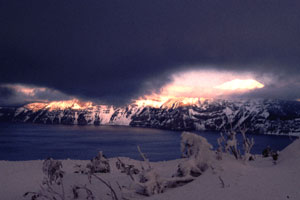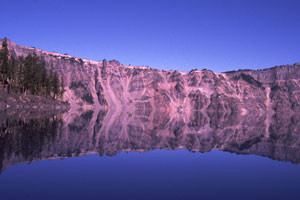Studies of Hydrothermal Processes in Crater Lake, Oregon – extracted from OSU College of Oceanography Report #90-7
Introduction
Crater Lake sits within the caldera of Mt. Mazama, a center of volcanism in the Oregon Cascades for more than 400,000 years. The morphology of the lake is largely a consequence of a climactic eruption that occurred 6845 + 50 years ago; however, intercaldera volcanism took place as recently as 4000 years ago. The volcanic morphology provides a basin for what is now the deepest lake in the United States (approximately 590 meters). The volcanic terrain strongly limits the nutrient fluxes into the lake, mostly because the lake covers 78% of the total drainage area. Consequently, the lake is highly oligotrophic and one of the clearest lakes in the world.
Our studies of Crater Lake began as an attempt to understand the important physical and chemical characteristics of the lake and the processes which produced some unusual sediment compositions, consistent with hydrothermal inputs to the lake. Given the location of the lake directly above a relatively recent and major magmatic source, thermal spring input to the lake would not be surprising. Such a source was first suggested by the USGS scientist Van Denburgh in 1968, who noted the relatively high sulfate and chloride content of Crater Lake as compared to nearby Davis Lake, and suggested that these two constituents ” …. may have been contributed to the lake by thermal springs or fumaroles, probably located below the present lake level. Such springs and fumaroles are a common expression of hydrothermal activity at a site of volcanic eruptions.”
 The question of whether there are hydrothermal sources to Crater Lake has important implications for understanding the lake ecology. For example, the relatively rapid mixing that has been suggested for Crater Lake may be a consequence of hydrothermal inputs of heat to the bottom of the lake. If this is true, temporal variability in this source could impact the nutrient cycling and the plant productivity of the lake. In 1987, in response to the requirement of Public Law 99-591 for identification of significant thermal features in national parks, the National Park Service funded a three-year program to evaluate possible hydrothermal sources to Crater Lake. The research, which is part of an ongoing limnological study of Crater Lake, was designed to: (1) define the thermal and chemical variability in the deep lake, (2) examine the data for evidence of a hydrothermal source, (3) design and carry out a program that would find possible venting sites and sample any associated fluids, and (4) evaluate alternative mechanisms to explain the observed thermal and chemical variability. The text and photos below offer a brief summary of the results from this research program. Since 1968, many other investigators have shown thermal, chemical, and isotopic evidence of active hydrothermal inputs to the lake. But evidence of hydrothermal sources to the lake have not gone unchallenged. Others argued against any hydrothermal inputs to the lake and suggested that underestimated evaporation rates, fumarolic inputs, and weathering of Mazama ash could account for the anomalous composition of the lake. They suggested that conductive heating rather than convective inputs accounts for the temperature anomalies.
The question of whether there are hydrothermal sources to Crater Lake has important implications for understanding the lake ecology. For example, the relatively rapid mixing that has been suggested for Crater Lake may be a consequence of hydrothermal inputs of heat to the bottom of the lake. If this is true, temporal variability in this source could impact the nutrient cycling and the plant productivity of the lake. In 1987, in response to the requirement of Public Law 99-591 for identification of significant thermal features in national parks, the National Park Service funded a three-year program to evaluate possible hydrothermal sources to Crater Lake. The research, which is part of an ongoing limnological study of Crater Lake, was designed to: (1) define the thermal and chemical variability in the deep lake, (2) examine the data for evidence of a hydrothermal source, (3) design and carry out a program that would find possible venting sites and sample any associated fluids, and (4) evaluate alternative mechanisms to explain the observed thermal and chemical variability. The text and photos below offer a brief summary of the results from this research program. Since 1968, many other investigators have shown thermal, chemical, and isotopic evidence of active hydrothermal inputs to the lake. But evidence of hydrothermal sources to the lake have not gone unchallenged. Others argued against any hydrothermal inputs to the lake and suggested that underestimated evaporation rates, fumarolic inputs, and weathering of Mazama ash could account for the anomalous composition of the lake. They suggested that conductive heating rather than convective inputs accounts for the temperature anomalies.
Other pages in this section
*** previous title *** --- *** next title ***



